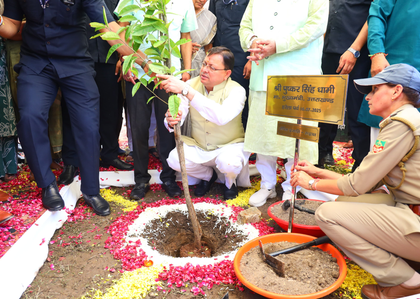Uttarakhand goes greener: Over 8 lakh trees planted state-wide during Harela Festival
By IANS | Updated: July 16, 2025 23:54 IST2025-07-16T23:49:23+5:302025-07-16T23:54:18+5:30
Dehradun, July 16 Uttarakhand witnessed a remarkable transformation as the ‘Harela festival’ evolved from a cultural tradition into ...

Uttarakhand goes greener: Over 8 lakh trees planted state-wide during Harela Festival
Dehradun, July 16 Uttarakhand witnessed a remarkable transformation as the ‘Harela festival’ evolved from a cultural tradition into a sweeping environmental movement on Wednesday.
With over 8.13 lakh saplings planted across all 13 districts, the state marked its largest-ever tree plantation drive on the occasion of any festival, turning the event into a symbol of ecological renewal and public participation.
Inspired by Prime Minister Narendra Modi’s call for environmental stewardship, Chief Minister Pushkar Singh Dhami expanded the “Ek Ped Maa Ke Naam” campaign into a statewide initiative themed “Celebrate Harela, Repay the Debt of Mother Earth.”
The Chief Minister personally launched the drive by planting a sapling in Dehradun, emphasising that the campaign was not merely a government program but a people’s movement rooted in shared responsibility.
Data from the state government shows that tree plantations across Uttarakhand’s districts during the Harela festival witnessed widespread and enthusiastic participation in the environmental campaign.
According to data, Champawat led the effort with over 1.24 lakh saplings planted, followed by Udham Singh Nagar at around 93,800 and Uttarkashi at just over 89,000. Significant contributions also came from Pithoragarh, Chamoli, and Garhwal, each reporting upwards of 60,000 plantings.
Even relatively smaller districts such as Bageshwar, Rudraprayag, and Nainital showed strong engagement, adding tens of thousands of trees to the collective total.
With more than 8.13 lakh plants rooted state-wide as of July 16, the data reflects not only the scale of the campaign but also the decentralisation of its impact - every district playing its part in painting Uttarakhand green.
From remote villages to bustling towns, thousands of plantation events unfolded simultaneously, involving local administrations, forest officials, schoolchildren, Anganwadi workers, women’s groups, and youth volunteers.
The collective effort painted Uttarakhand in shades of green, reinforcing the state’s identity as a land deeply connected to nature and committed to sustainable development.
Harela, traditionally celebrated to mark the onset of the monsoon and the agricultural cycle, has long been a reflection of Uttarakhand’s cultural soul. But this year, the festival took on a new dimension - one that fused heritage with environmental consciousness.
The saplings planted were not just trees but living symbols of hope, resilience, and the promise of a greener future.
Chief Minister Dhami underscored that Uttarakhand is not only a Himalayan state but a beacon of civic awareness and ecological responsibility.
He reiterated the government’s commitment to balancing development with environmental preservation, stating that protecting forests, water sources, and land is central to the state’s policy framework.
As the planted seeds take root, they represent more than just foliage - they embody a collective awakening. The Harela festival of 2025 will be remembered not just for its rituals and celebrations but for mobilising an entire state toward a greener, more sustainable tomorrow.
Disclaimer: This post has been auto-published from an agency feed without any modifications to the text and has not been reviewed by an editor
Open in app